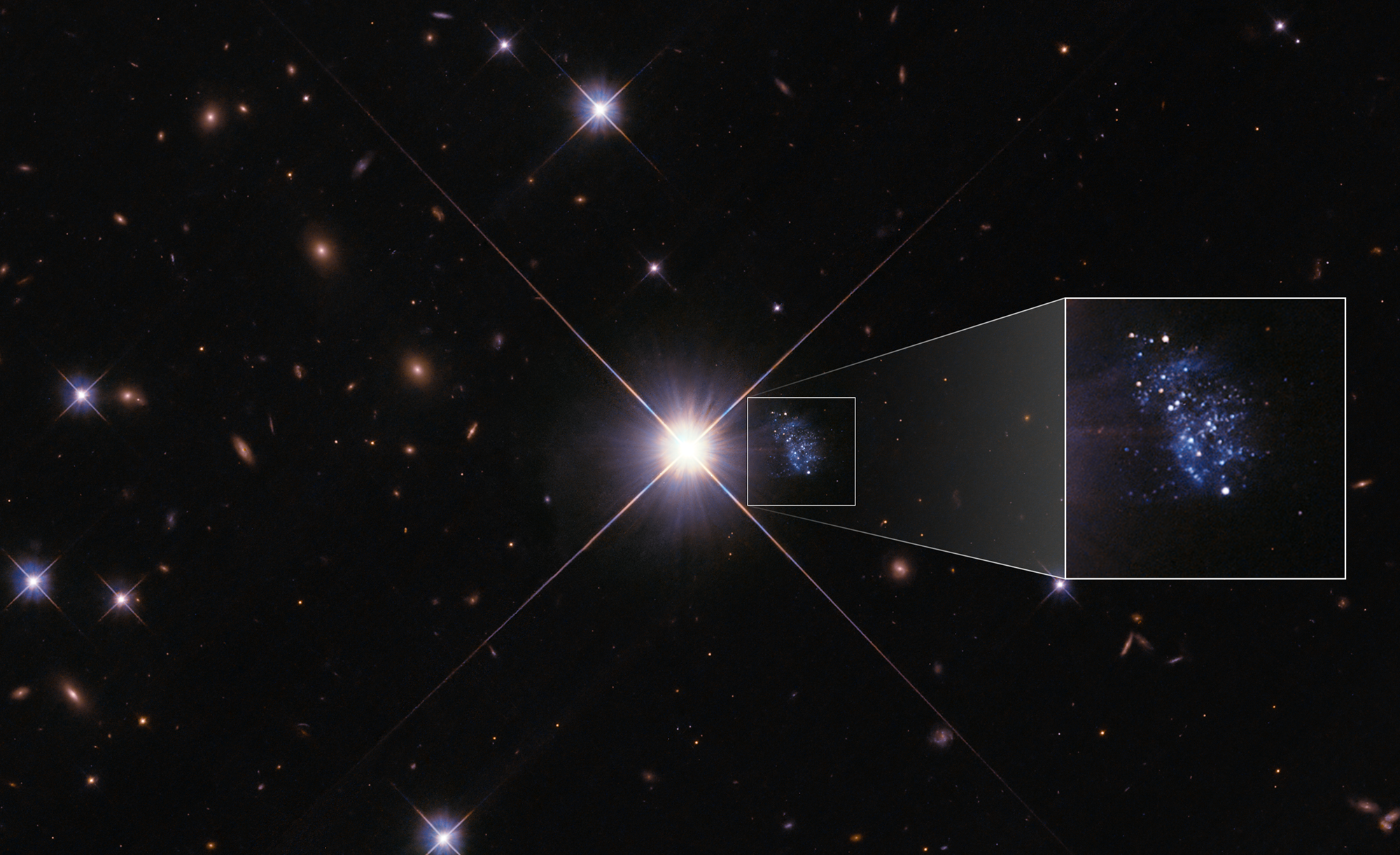Astronomers have discovered the most extraordinary example of a nearby galaxy with properties that are more similar to galaxies in the distant, early universe by peering out from behind the glare of a bright foreground star.

NASA’s Hubble Space Telescope captured a detailed image of the tiny galaxy HIPASS J1131–31, nicknamed the “Peekaboo Galaxy,” despite its proximity to a bright foreground star. In addition to Hubble imagery, astronomers used the South African Large Telescope to collect detailed spectroscopic data on the galaxy’s stars, which show it to be one of the least chemically enriched galaxies ever discovered in the local universe. Image Credit: NASA, ESA, and Igor Karachentsev (SAO RAS); Image Processing: Alyssa Pagan (STScI)
The tiny galaxy HIPASS J1131-31, which measures just 1,200 light-years across, has earned the moniker “Peekaboo” due to its recent appearance from behind a fast-moving star that had previously prevented astronomers from seeing it.
A combination of ground-based and space-based telescopes, including NASA’s Hubble Space Telescope, contributed to the discovery. Together, the studies provide tantalizing proof that the Peekaboo Galaxy is the closest illustration of the galaxy formation processes that frequently occurred shortly after the big bang, 13.8 billion years ago.
Uncovering the Peekaboo Galaxy is like discovering a direct window into the past, allowing us to study its extreme environment and stars at a level of detail that is inaccessible in the distant, early universe.
Gagandeep Anand, Astronomer, Space Telescope Science Institute
Galaxies like Peekaboo are described by astronomers as being “extremely metal-poor” (XMP). In astronomy, all elements heavier than hydrogen and helium are referred to as “metals.”
The elements created in the big bang, primordial hydrogen and helium, made up almost the entire very early universe. Over the course of cosmic history, heavier elements were created by stars, leading to the primarily metal-rich universe we inhabit today. The “building blocks” of life are composed of heavier elements like calcium, iron, carbon, and oxygen.
Although the earliest galaxies in the universe were XMP by default, similar metal-poor galaxies have also been discovered in the nearby universe.
Peekaboo attracted astronomers’ attention because, in addition to being an XMP galaxy without a significantly older stellar population, it is also at least half the distance from Earth—20 million light-years—than the other known young XMP galaxies.
Professor Bärbel Koribalski, an astronomer at Australia’s national science agency CSIRO and a co-author of the most recent study on Peekaboo’s metallicity, made the initial discovery of Peekaboo as a region of cold hydrogen more than 20 years ago with the Australian Parkes radio telescope Murriyang in the HI Parkes All Sky Survey.
It was identified as a compact blue dwarf galaxy by NASA’s far-ultraviolet Galaxy Evolution Explorer mission.
At first, we did not realize how special this little galaxy is. Now with combined data from the Hubble Space Telescope, the Southern African Large Telescope (SALT), and others, we know that the Peekaboo Galaxy is one of the most metal-poor galaxies ever detected.
Bärbel Koribalski, Study Co-Author and Astronomer, Commonwealth Scientific and Industrial Research Organization
In the tiny galaxy, about 60 stars that are all thought to be a few billion years old or younger were resolved by NASA’s Hubble Space Telescope. The picture was completed by SALT measurements of Peekaboo’s metallicity.
When taken as a whole, these results highlight Peekaboo’s significant distinction from other galaxies in the local universe, which typically have old stars that are many billions of years old.
The stars in Peekaboo suggest that it is one of the most recent and least chemically enriched galaxies to be found in the nearby universe. Given that the local universe has had about 13 billion years for cosmic history to develop, this is very unusual.
Anand claims that despite this, the picture is still limited because the Hubble observations were made as part of a “snapshot” survey program called Every Known Nearby Galaxy Survey, which aimed to collect Hubble data from as many nearby galaxies as possible.
To better understand the stellar populations and metal composition of Peekaboo, the research team intends to conduct additional observations using Hubble and the James Webb Space Telescope.
Anand further added, “Due to Peekaboo’s proximity to us, we can conduct detailed observations, opening up possibilities of seeing an environment resembling the early universe in unprecedented detail.”
The findings have been approved for publication in the Monthly Notices of the Royal Astronomical Society.
NASA and ESA worked together internationally to create the Hubble Space Telescope. Located in Greenbelt, Maryland, NASA’s Goddard Space Flight Center is in charge of the telescope.
Hubble science operations are managed by the STScI, a Baltimore-based organization. The Washington, D.C.-based Association of Universities for Research in Astronomy runs STScI for NASA.